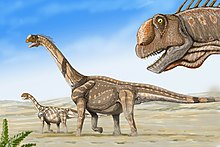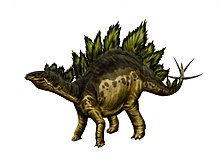1877 in paleontology
 From Wikipedia the free encyclopedia
From Wikipedia the free encyclopedia
| |||
|---|---|---|---|
| +... |
Paleontology or palaeontology is the study of prehistoric life forms on Earth through the examination of plant and animal fossils.[1] This includes the study of body fossils, tracks (ichnites), burrows, cast-off parts, fossilised feces (coprolites), palynomorphs and chemical residues. Because humans have encountered fossils for millennia, paleontology has a long history both before and after becoming formalized as a science. This article records significant discoveries and events related to paleontology that occurred or were published in the year 1877.
Arthropods[edit]
Newly named crustaceans[edit]
| Name | Novelty | Status | Authors | Age | Unit | Location | Notes | Images |
|---|---|---|---|---|---|---|---|---|
| Sp nov | jr synonym | Moved to the genus Tealliocaris in 1908[3] |
Newly named insects[edit]
| Name | Novelty | Status | Authors | Age | Type locality | Country | Notes | Images |
|---|---|---|---|---|---|---|---|---|
| Sp nov | Quesnel | An anthomyiid fly. |  (1890 illustration) | |||||
| Sp nov | Quesnel | An anthomyiid fly. |  (1890 illustration) | |||||
| Sp nov | Quesnel | A myrmicine ant, possibly nomen dubium.[7] |  (1890 illustration) | |||||
| Sp nov | valid | Quesnel | A fungus gnat. | 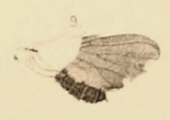 (1890 illustration) | ||||
| Sp nov | valid | Quesnel |  (1890 illustration) | |||||
| Sp nov | valid | Quesnel |  (1890 illustration) | |||||
| Gen et sp nov | valid | Quesnel | An ant of uncertain placement. |  (1890 illustration) | ||||
| Sp nov | valid | Quesnel | A formicine ant | 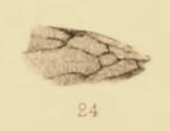 (1890 illustration) | ||||
| Sp nov | jr synonym | Quesnel | A dolichoderine ant |  (1890 illustration) | ||||
| Sp nov | valid | Quesnel |  (1890 illustration) | |||||
| Sp nov | jr synonym | Quesnel | An aphidomorph of uncertain placement |  (1890 illustration) | ||||
| Sp nov | valid | An ant species, moved to Eoformica pingue in 1930 |  | |||||
| Gen et sp nov | valid | Quesnel | A picture-winged fly. |  (1890 illustration) | ||||
| Sp nov | valid | Quesnel | A lauxaniid fly. |  (1890 illustration) | ||||
| Sp nov | valid | Quesnel |  (1890 illustration) | |||||
| Sp nov | valid | Quesnel |  (1890 illustration) | |||||
| Sp nov | valid | Quesnel |  (1890 illustration) | |||||
| Sp nov | valid | Quesnel | 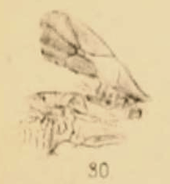 (1890 illustration) | |||||
| Sp nov | valid | Quesnel |  (1890 illustration) | |||||
| Sp nov | valid | Quesnel | A marsh fly. |  (1890 illustration) | ||||
| Sp nov | valid | Quesnel | 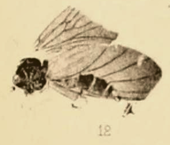 (1890 illustration) |
Fish[edit]
| Name | Novelty | Status | Authors | Age | Unit | Location | Notes | Images |
|---|---|---|---|---|---|---|---|---|
| gen et sp nov. | Valid | One of two stingrays from the Green River Formation |  |
Non-dinosaurian reptiles[edit]
| Name | Novelty | Status | Authors | Age | Unit | Location | Notes | Images |
|---|---|---|---|---|---|---|---|---|
| Junior synonym | Late Triassic | A misidentified ornithosuchid archosaur whose name was preoccupied by MacLeay, 1819. It was later renamed Dasygnathoides. Synonym of Ornithosuchus | ||||||
| Late Triassic | Dubious genus of misidentified phytosaur. | |||||||
| Dubious genus of misidentified phytosaur. |
Dinosaurs[edit]
Laelaps trihedrodon, Cope criticizes Dryptosaurus[edit]
O. W. Lucas collected the first remains of what would later in the year be named Laelaps trihedrodon from Quarry I of the Saurian Hill at Garden Park, Colorado.[12] Edward Drinker Cope would describe the material later in the year in a short paper titled "On a carnivorous dinosaurian from the Dakota beds of Colorado."[13] The "Dakota beds" he references are actually Morrison Formation strata.[12] Cope claims to have a skeleton of unspecified completeness on which to establish the new species, but only describes a partial dentary which has 5 successional teeth, 2 functional teeth, and one tooth missing from its socket.[13] All of the preceding material has since been lost to science with the exception of 5 broken, partial tooth crowns.[14] From the now missing dentary, Cope infers that the creature is a carnivore and compares its dentition to that belonging to other members of his infamous genus "Laelaps", L. aquilunguis and L. incrassatus.[13] Cope concludes the paper with a pointed criticism of his rival O. C. Marsh's attempt to rename Laelaps as the genus Dryptosaurus because the generic name Laelaps has been used in entomology.[15] Cope claims that since the mite genus Laelaps was a synonym that the name was not truly preoccupied and Marsh's erection of Dryptosaurus has therefore created a new, redundant synonym of Laelaps the dinosaur.[15] However, subsequent researchers have supported Marsh's new name.
Apatosaurus[edit]
- Apatosaurus specimen found with preserved gastroliths.[16]
New genera[edit]
| ||||||||||||||||||||||||||||||||||||||||||||||||||||||||||||||||||||||||||||||||||||||||||||||||||||||||||||||||||||||||||
Synapsids[edit]
Non-mammalian[edit]
| Name | Status | Authors | Age | Location | Notes | Images |
|---|---|---|---|---|---|---|
| Synonym of Clepsydrops |
See also[edit]
Footnotes[edit]
- ^ Gini-Newman, Garfield; Graham, Elizabeth (2001). Echoes from the past: world history to the 16th century. Toronto: McGraw-Hill Ryerson Ltd. ISBN 9780070887398. OCLC 46769716.
- ^ Etheridge, R. (1877). "On the Occurrence of a Macrurous Decapod (Anthrapalæmon? Woodwardi, sp. nov.) in the Red Sandstone, or lowest group, of the Carboniferous Formation in the South-east of Scotland". Quarterly Journal of the Geological Society. 33 (1–4): 863–878. doi:10.1144/GSL.JGS.1877.033.01-04.49. ISSN 0370-291X. S2CID 140182850.
- ^ Peach, B. N. (1908). Monograph on the higher Crustacea of the Carboniferous rocks of Scotland. Glasgow: Printed for H.M. Stationery off., by J. Hedderwick & sons, ltd.
- ^ a b c d e f g h i j k l m n o p q r s t Scudder, S. H (1877). "Appendix to Mr. George M. Dawson's report. The insects of the Tertiary beds at Quesnel". Geological Survey of Canada, Report of Progress for. 1875–1876: 266–280.
- ^ a b Michelsen, V. (1996). "First reliable record of a fossil species of Anthomyiidae (Diptera), with comments on the definition of recent and fossil clades in phylogenetic classification". Biological Journal of the Linnean Society. 58 (4): 441–451.
- ^ a b Carpenter, F. M. (1930). "The fossil ants of North America" (PDF). Bulletin of the Museum of Comparative Zoology. 70: 1–66.
- ^ Radchenko, A. G.; Perkovsky, E. E. (2016). "The ant Aphaenogaster dlusskyana sp. nov. (Hymenoptera, Formicidae) from the Sakhalin amber—the earliest described species of an extant genus of Myrmicinae". Paleontological Journal. 50 (9): 936–946. doi:10.1134/S0031030116090136.
- ^ Dalla Torre, K. W. (1893). Catalogus Hymenopterorum hucusque descriptorum systematicus et synonymicus. Vol. 7. Formicidae (Heterogyna). Leipzig: W. Engelmann. p. 289.
- ^ Scudder, S. H. (1890). "The Tertiary insects of North America". United States Geological Survey of the Territories, Washington: 615.
- ^ Evenhuis (1994). Catalogue of the Fossil Flies of the World (Insecta: Diptera). Backhuys Publishers. pp. 1–600.
- ^ Grande, Lance (1984), "Paleontology of the Green River Formation, with a review of the fish fauna", Bulletin of the Wyoming State Geological Survey, 63 2nd ed., Laramie, WY
- ^ a b "Introduction," Chure (2001) page 11.
- ^ a b c Cope (1887) pages 805-806.
- ^ "Description of 5780," Chure (2001) page 11.
- ^ a b Cope (1887) page 806.
- ^ Cannon (1907). Sanders, Manley, and Carpenter (2001), "Table 12.1" page 167.
References[edit]
- Cannon, G.L. (1907). Sauropodan gastroliths. Science 24, 116.
- Chure, Daniel J. (2001). "On the type and referred material of Laelaps trihedrodon Cope 1877 (Dinosauria: Theropoda)". In Tanke, Darren; Carpenter, Kenneth (eds.). Mesozoic Vertebrate Life. Bloomington and Indianapolis: Indiana University Press. pp. 10–18. ISBN 0-253-33907-3.
- Cope, E.D. (1877). On a carnivorous dinosaurian from the Dakota beds of Colorado. Bull. U.S. Geol. Surv. Territories 3: 805–806.
- Sanders F, Manley K, Carpenter K. Gastroliths from the Lower Cretaceous sauropod Cedarosaurus weiskopfae. In: Tanke D.H, Carpenter K, editors. Mesozoic vertebrate life: new research inspired by the paleontology of Philip J. Currie. Indiana University Press; Bloomington, IN: 2001. pp. 166–180.



